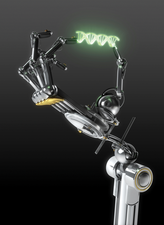Controlling a four-axis robot arm
Gentle Touch

© Lead Image © marc heriche, Fotolia.com
Learn the basics of robotics with a Raspberry Pi and a PiXtend controller.
Robotics might seem like a daunting subject to tackle, but a Raspberry Pi, a PiXtend module, Codesys control software, and a bit of Structured Text (ST) programming are all you need to get started in this compelling discipline. In this article, I describe how to set up and program a robot arm.
For this project, I opted for the four-axis robot arm by SainSmart [1]; it has a good price-to-performance ratio and a large working range. Simple hobby servos let the robot arm equipped with a simple gripper [2] move objects. The Thingiverse website provides the 3D printer files for printing the gripper [3]; alternatively, you can purchase the gripper on Amazon [4]. The gripper also is driven by a servo and requires a PWM signal for control. For more information on servos, see the box "How Servos Work."
The best way to keep track of the motors is to label each one (Table 1). Figure 2 shows the robot with the gripper, and the wiring diagram in Figure 3 shows how to connect the individual motors. Please note that hobby servos can handle a maximum of 6V.
[...]
Buy this article as PDF
(incl. VAT)
Buy Linux Magazine
Subscribe to our Linux Newsletters
Find Linux and Open Source Jobs
Subscribe to our ADMIN Newsletters
Support Our Work
Linux Magazine content is made possible with support from readers like you. Please consider contributing when you’ve found an article to be beneficial.

News
-
Parrot OS Switches to KDE Plasma Desktop
Yet another distro is making the move to the KDE Plasma desktop.
-
TUXEDO Announces Gemini 17
TUXEDO Computers has released the fourth generation of its Gemini laptop with plenty of updates.
-
Two New Distros Adopt Enlightenment
MX Moksha and AV Linux 25 join ranks with Bodhi Linux and embrace the Enlightenment desktop.
-
Solus Linux 4.8 Removes Python 2
Solus Linux 4.8 has been released with the latest Linux kernel, updated desktops, and a key removal.
-
Zorin OS 18 Hits over a Million Downloads
If you doubt Linux isn't gaining popularity, you only have to look at Zorin OS's download numbers.
-
TUXEDO Computers Scraps Snapdragon X1E-Based Laptop
Due to issues with a Snapdragon CPU, TUXEDO Computers has cancelled its plans to release a laptop based on this elite hardware.
-
Debian Unleashes Debian Libre Live
Debian Libre Live keeps your machine free of proprietary software.
-
Valve Announces Pending Release of Steam Machine
Shout it to the heavens: Steam Machine, powered by Linux, is set to arrive in 2026.
-
Happy Birthday, ADMIN Magazine!
ADMIN is celebrating its 15th anniversary with issue #90.
-
Another Linux Malware Discovered
Russian hackers use Hyper-V to hide malware within Linux virtual machines.

